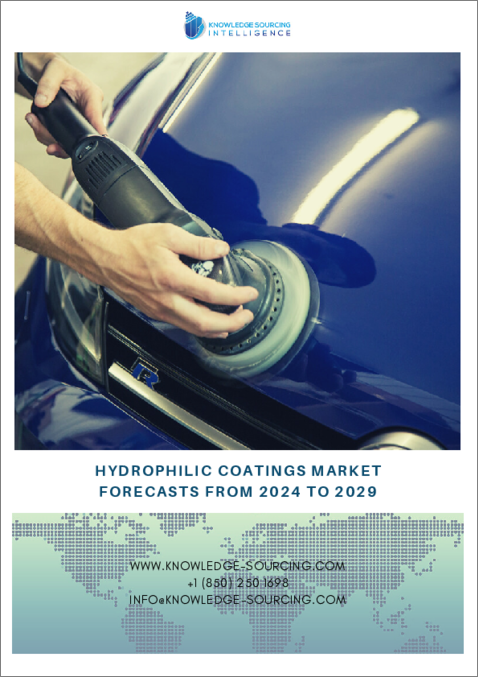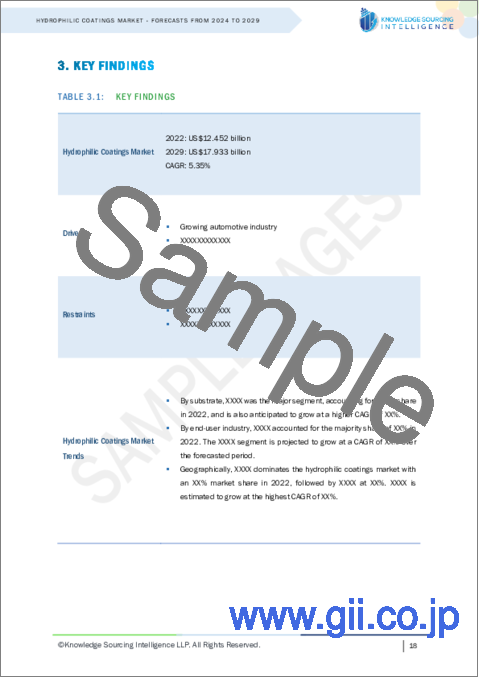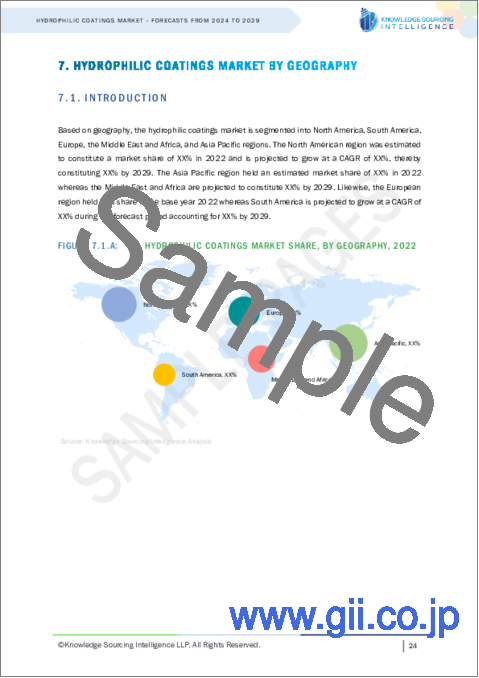|
|
市場調査レポート
商品コード
1302920
親水性コーティング市場-2023年から2028年までの予測Hydrophilic Coatings Market - Forecasts from 2023 to 2028 |
||||||
|
● お客様のご希望に応じて、既存データの加工や未掲載情報(例:国別セグメント)の追加などの対応が可能です。 詳細はお問い合わせください。 |
|||||||
| 親水性コーティング市場-2023年から2028年までの予測 |
|
出版日: 2023年06月16日
発行: Knowledge Sourcing Intelligence
ページ情報: 英文 141 Pages
納期: 即日から翌営業日
|
- 全表示
- 概要
- 目次
親水性コーティング市場の2021年の市場規模は121億2,100万米ドルでした。
親水性コーティングは、水分や湿気を引き寄せ保持するように設計された特殊な保護バリアです。親水性コーティングは、表面を水やその他の液体で湿らせたり、浸したりする必要がある用途で特に有用であり、表面全体に均一に塗布することで、製品の性能や耐久性を向上させると同時に、表面の洗浄やメンテナンスのしやすさも向上させる。親水性コーティングは、自動車、光学、海洋、医療機器、その他の産業で使用されるポリマー、金属、ガラス&セラミック、ナノ粒子基板に適用されます。親水性コーティングは水性であることが多く、従来の溶剤ベースのコーティング剤よりも揮発性有機化合物の含有量が少ないため、持続可能で環境に優しいコーティング剤への需要の高まりが親水性コーティングの需要を増加させると予想されます。さらに、潤滑性、生体適合性、耐久性などの特性を向上させるための新素材やコーティング技術を用いた親水性コーティングの開発が、親水性コーティング市場の成長を促進しています。
市場促進要因:
自動車分野からの需要の高まり
親水性コーティングは、ブレーキパッド、ローター、その他の金属部品など、さまざまな自動車部品に広く採用されており、摩擦を減らし潤滑性を向上させることで、性能と寿命を向上させています。修理や交換の必要性を減らすことで、これらの部品の寿命を延ばすのに役立っています。さらに、親水性コーティングは自動車ガラスにも使用することができ、曇り止め効果により濡れた状態での視認性を向上させます。自動車セクターによる自動車の消費拡大により、このセクター全体で親水性コーティングの消費が増加すると予想されます。例えば、インド自動車工業会の報告によると、インド自動車産業による自動車の年間総生産台数は、2022年3月の2,304万66台から2023年3月には2,593万1,867台に増加しました。
親水性コーティング技術の発展
親水性コーティング技術の開発は、ソーラーパネルのコーティング技術の成長に後押しされ、太陽エネルギー需要の増加により親水性コーティングの需要を促進すると予想されます。例えば、2022年3月、太陽電池を製造するフランスのPhotowatt社とフランスの化学会社Axcentive社が共同で、雨天時の光の散乱を防ぐために太陽電池モジュール全体に塗布する光活性ナノテクノロジーとセルフクリーニング特性を備えた新しい超親水性コーティング製品を発売しました。さらに、チェンマイ大学の科学者たちは、反射防止、光触媒コーティング、防汚特性を備えた新しい超親水性コーティングを開発し、チタンワイヤーを通して商業用ソーラーパネルの歩留まりを6%向上させました。ナノテクノロジーの進歩は、さらに新しい親水性コーティングの革新につながっています。例えば、2023年2月、オーストラリアのナノテクノロジー企業であるNanovue社は、藻の繁殖を防ぎ、ソーラーガラス全体の表面ゴミを減らすセルフクリーニング特性を持つ新しい多機能親水性ナノコーティングを発表しました。持続可能性への高い需要に牽引されたソーラーパネルとソーラーシステムの消費増加、およびソーラーシステム全体で使用される最近のコーティング技術開発は、予測期間中に親水性コーティングの需要を刺激すると予想されます。
エンドユーザー産業別では、医療機器・装置分野が市場シェアを大きく伸ばすと予測されています。
親水性コーティングは、カテーテル、ガイドワイヤー、ステントなどの医療機器に広く使用され、潤滑性を向上させ、挿入時や使用時の摩擦を軽減します。低侵襲手術や医療処置の需要が増加しているため、医療業界では親水性コーティングの需要が高いです。さらに、親水性コーティングは、非親水性コーティング潤滑剤に比べ、抗菌性や生物医学的に安全であるという点で相対的に優れており、抗感染特性による費用対効果や多機能性という利点も同時に備えているため、医療機器や器具全体での消費が増加しています。
疎水性コーティングのような代替技術の利用可能性と特定の規制上の問題が、市場の成長を制限する可能性があります。
疎水性コーティングのような代替コーティング技術は、視界を遮る雨滴を防ぐために自動車用ガラスに適用される可能性があり、親水性コーティングの広範な消費を制限します。さらに、親水性コーティングを医療機器などの特定の用途に開発・使用する場合、規制当局の承認が必要となり、その結果、遅延や追加コストが発生し、市場の成長が制限される可能性があります。
市場動向:
- 2021年3月、さまざまな内視鏡機器を製造する英国の医療企業Lumendi Ltd.は、内視鏡アプリケーションとして一般的に使用される内腔デバイス全体に使用される新しい親水性コーティングEZ Glideの発売を宣言しました。
- 2022年4月、親水性コーティング技術と生体材料コーティングを専門とする米国のBiocoat Inc.は、医療機器への親水性ディップコーティング装置システムの使用を容易にする新しい生産ラインEMERSEを導入しました。
- 2020年2月、Biocoat Inc.は、業界標準に基づくUVコーティングシステムの柔軟な融合を促進するため、熱硬化コーティングに使用されているバイラミナー技術により駆動される新しい親水性コーティング製品、HYDAK UVを発表しました。
アジア太平洋地域は親水性コーティング市場で大きなシェアを占めており、予測期間中も成長が見込まれています。
アジア主要国での医療機器や光学機器生産の伸びが、同地域の親水性コーティング市場を牽引すると見られています。例えば、IBEFは、2021年にインドで製造された医療機器の総額は120億米ドルに達することを明らかにしました。さらに、中国、日本、韓国などの国々でもヘルスケア・医療機器分野の拡大が見られます。例えば、2022年の中国からインドへの医療機器輸入額は6,320億ルピーで、2021年の4,470億8,000万ルピーから41%増加しました。
目次
第1章 イントロダクション
- 市場概要
- 市場の定義
- 調査範囲
- 市場セグメンテーション
- 通貨
- 前提条件
- 基準年と予測年のタイムライン
第2章 調査手法
- 調査データ
- 調査プロセス
第3章 エグゼクティブサマリー
- 調査ハイライト
第4章 市場力学
- 市場促進要因
- 市場抑制要因
- ポーターのファイブフォース分析
- 業界バリューチェーン分析
第5章 親水性コーティング市場:基材別
- イントロダクション
- ポリマー
- 金属
- ガラス・セラミックス
- ナノ粒子
第6章 親水性コーティング市場:エンドユーザー産業別
- イントロダクション
- 自動車
- 光学機器
- 船舶
- 医療機器・装置
- その他
第7章 親水性コーティング市場:地域別
- イントロダクション
- 北米
- 米国
- カナダ
- メキシコ
- 南米
- ブラジル
- アルゼンチン
- その他
- 欧州
- ドイツ
- フランス
- 英国
- スペイン
- その他
- 中東・アフリカ
- サウジアラビア
- アラブ首長国連邦
- イスラエル
- その他
- アジア太平洋
- 中国
- 日本
- インド
- 韓国
- インドネシア
- タイ
- 台湾
- その他
第8章 競合環境と分析
- 主要企業と戦略分析
- 新興企業と市場収益性
- 合併、買収、合意およびコラボレーション
- ベンダー競争力マトリックス
第9章 企業プロファイル
- AST Products Inc.
- Joninn
- Hydromer Inc
- Aculon
- Applied Medical Coatings
- Harland Medical Systems Inc.
- Sigma Aldrich
- Surmodics Incorporated
- Biocoat, Inc
- DSM
The hydrophilic coatings market was valued at US$12.121 billion in 2021.
Hydrophilic coatings are specialized and protective barriers designed to attract and retain water content and moisture. They are particularly useful in applications where the surface needs to be damp or soaked in water or other liquids to facilitate an evenly spread application across a surface to improve the performance and durability of the product by simultaneously enhancing the ease of cleaning and maintaining such surfaces. Hydrophilic coatings are applied across polymer, metal, glass & ceramics, and nanoparticle substrates used in the automotive, optics, marine, medical devices & equipment, and other industries. The increasing demand for sustainable and eco-friendly coatings is expected to increase the demand for hydrophilic coatings as hydrophilic coatings are often water-based and contain fewer volatile organic compounds than traditional solvent-based coatings. Further, the development of hydrophilic coatings using new materials and coating technologies to improve properties such as enhanced lubricity, biocompatibility, and durability is driving the growth of the hydrophilic coatings market.
Market Drivers:
Rising demand from the automotive sector
Hydrophilic coatings are extensively adopted in the automotive sector across various automotive components such as brake pads, rotors, and other metal components to improve their performance and longevity by reducing friction and improving lubricity. They aid in extending the life of these components by reducing the need for repairs and replacements. In addition, hydrophilic coatings can also be used on automotive glass to improve visibility in wet conditions due to their anti-fog properties, which help to prevent water from beading up on the surface of the glass, reducing the probability of glare occurrence and improving road visibility. The expanding consumption of vehicles manufactured by the automotive sector is expected to increase the consumption of hydrophilic coatings across this sector. For instance, the Society of Indian Automobile Manufacturers reported that the aggregate annual production of vehicles by the Indian automotive industry increased from 2,30,40,066 units in March 2022 to 2,59,31,867 units in March 2023.
Developments in hydrophilic coating technology
The developments in hydrophilic coating technology fueled by the growth in solar panel coating technology are expected to promote the demand for hydrophilic coatings due to the rising demand for solar energy. For instance, in March 2022, Photowatt, a French company manufacturing PV cells, and Axcentive, a chemical company in France, collaborated to launch a new super-hydrophilic coating product with photoactive nanotechnology and self-cleaning properties to be applied across solar modules to prevent the scattering of light during rains. In addition, scientists at Chiang Mai University developed a new super hydrophilic coating with anti-reflective, photocatalytic coating, and anti-soiling properties to increase the yield of commercial solar panels by 6% through titanium wires. The advancements in nanotechnology are further leading to the innovation of new hydrophilic coatings. For instance, in February 2023, Nanovue, a nanotechnology company in Australia, introduced a new multifunctional hydrophilic nanocoating with self-cleaning properties to prevent algae growth and reduce surface debris across solar glass. The rising consumption of solar panels and systems driven by the high demand for sustainable and the recent coating technology developments to be used across solar systems are expected to stimulate the demand for hydrophilic coatings over the forecast period.
By end-user industry, the medical devices and equipment segment is anticipated to increase its market share prominently.
Hydrophilic coatings are extensively used in medical devices and equipment, such as catheters, guidewires, and stents, to improve lubricity and reduce friction during insertion and use. The increasing demand for minimally invasive surgeries and medical procedures results in a high demand for hydrophilic coatings in the medical industry. Further, the relative superiority of hydrophilic coatings over non-hydrophilic coated lubricants due to their antibacterial and biomedically safe qualities and the simultaneous advantage of cost-effectiveness and multifunctionality driven by its anti-infection properties is increasing its consumption across medical equipment and devices.
The availability of substitutions like hydrophobic coatings and certain regulatory issues could restrict the market's growth.
Substitute coating technologies such as hydrophobic coatings could be applied across vehicle glasses to prevent the raindrops from blocking the view, limiting the widespread consumption of hydrophilic coatings. Further, the development and use of hydrophilic coatings in certain applications, such as medical devices, could be subject to regulatory approval, resulting in delays and additional costs, leading to restricted market growth.
Market Developments:
- In March 2021, Lumendi Ltd., a UK-based medical company producing different endoscopy equipment, declared the launch of a new hydrophilic coating, EZ Glide, to be used across endoluminal devices commonly used as endoscopic applications.
- In April 2022, Biocoat Inc., a US-based company specializing in hydrophilic coating technology and biomaterial coatings, introduced a new production line, EMERSE, to facilitate the use of hydrophilic dip coating equipment systems on medical devices.
- In February 2020, Biocoat Inc. introduced a new hydrophilic coating product, HYDAK UV, driven by bi-laminar technology used in its thermal heat cure coating to facilitate a flexible merge of UV coating systems based on industry standards.
Asia Pacific holds a substantial market share of the hydrophilic coatings market and is expected to grow in the forecast period.
The growth in medical equipment and optics production across major Asian nations is expected to drive the hydrophilic coatings market in the region. For example, the IBEF revealed that the aggregate value of medical devices manufactured in India in 2021 amounted to US$12 billion. Further, countries like China, Japan, and South Korea are also witnessing an expanding healthcare and medical equipment sector. For instance, Chinese medical equipment imports to India amounted to Rs.63,200 crore in 2022, which increased by 41% from its value of Rs.44,708 crore in 2021.
Market Segmentation:
By Substrate
- Polymer
- Metal
- Glass & Ceramics
- Nanoparticles
By End-User Industry
- Automotive
- Optics
- Marine
- Medical Devices & Equipment
- Others
By Geography
- North America
- USA
- Canada
- Mexico
- South America
- Brazil
- Argentina
- Others
- Europe
- Germany
- France
- United Kingdom
- Spain
- Others
- Middle East and Africa
- Saudi Arabia
- UAE
- Israel
- Others
- Asia Pacific
- China
- Japan
- India
- South Korea
- Indonesia
- Thailand
- Taiwan
- Others
TABLE OF CONTENTS
1. INTRODUCTION
- 1.1. Market Overview
- 1.2. Market Definition
- 1.3. Scope of the Study
- 1.4. Market Segmentation
- 1.5. Currency
- 1.6. Assumptions
- 1.7. Base, and Forecast Years Timeline
2. RESEARCH METHODOLOGY
- 2.1. Research Data
- 2.2. Research Process
3. EXECUTIVE SUMMARY
- 3.1. Research Highlights
4. MARKET DYNAMICS
- 4.1. Market Drivers
- 4.2. Market Restraints
- 4.3. Porter's Five Force Analysis
- 4.3.1. Bargaining Power of Suppliers
- 4.3.2. Bargaining Power of Buyers
- 4.3.3. Threat of New Entrants
- 4.3.4. Threat of Substitutes
- 4.3.5. Competitive Rivalry in the Industry
- 4.4. Industry Value Chain Analysis
5. HYDROPHILIC COATINGS MARKET BY SUBSTRATE
- 5.1. Introduction
- 5.2. Polymer
- 5.3. Metal
- 5.4. Glass & Ceramics
- 5.5. Nanoparticles
6. HYDROPHILIC COATINGS MARKET BY END-USER INDUSTRY
- 6.1. Introduction
- 6.2. Automotive
- 6.3. Optics
- 6.4. Marine
- 6.5. Medical Devices & Equipment
- 6.6. Others
7. HYDROPHILIC COATINGS MARKET BY GEOGRAPHY
- 7.1. Introduction
- 7.2. North America
- 7.2.1. USA
- 7.2.2. Canada
- 7.2.3. Mexico
- 7.3. South America
- 7.3.1. Brazil
- 7.3.2. Argentina
- 7.3.3. Others
- 7.4. Europe
- 7.4.1. Germany
- 7.4.2. France
- 7.4.3. United Kingdom
- 7.4.4. Spain
- 7.4.5. Others
- 7.5. Middle East and Africa
- 7.5.1. Saudi Arabia
- 7.5.2. UAE
- 7.5.3. Israel
- 7.5.4. Others
- 7.6. Asia Pacific
- 7.6.1. China
- 7.6.2. Japan
- 7.6.3. India
- 7.6.4. South Korea
- 7.6.5. Indonesia
- 7.6.6. Thailand
- 7.6.7. Taiwan
- 7.6.8. Others
8. COMPETITIVE ENVIRONMENT AND ANALYSIS
- 8.1. Major Players and Strategy Analysis
- 8.2. Emerging Players and Market Lucrativeness
- 8.3. Mergers, Acquisitions, Agreements, and Collaborations
- 8.4. Vendor Competitiveness Matrix
9. COMPANY PROFILES
- 9.1. AST Products Inc.
- 9.2. Joninn
- 9.3. Hydromer Inc
- 9.4. Aculon
- 9.5. Applied Medical Coatings
- 9.6. Harland Medical Systems Inc.
- 9.7. Sigma Aldrich
- 9.8. Surmodics Incorporated
- 9.9. Biocoat, Inc
- 9.10. DSM




